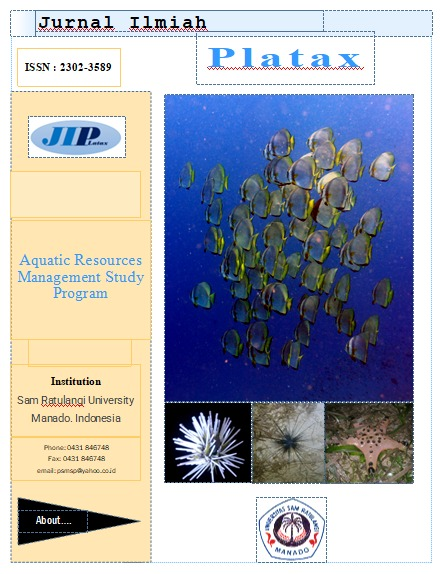Study of Welfare Level of Fisherman Community in Alo Village, Rainis District, Talaud Islands Regency
DOI:
https://doi.org/10.35800/jip.v11i1.44396Keywords:
Alo Village;, Welfare;, Income;, Expenditures;, education;Abstract
Talaud Islands Regency is a maritime area with a sea area of around 37,800 km² (95.24%) and a land area of 1,251.02 km². The fishing community in Alo Village utilizes fishery resources as their main source of life. especially the coastal community of Alo village which is dominated by fishermen who are classified as labor fishermen or small fishermen. Fishing communities are small groups of people living in coastal areas whose main livelihood is utilizing the natural resources found in the ocean, whether in the form of fish, shrimp, seaweed, shellfish, coral reefs and other marine wealth. To determine the level of welfare of the fishing community in Alo Village. The type of research method used in this research is census research using descriptive analysis. So it can be concluded that the level of welfare of the fishing community in Alo Village, Rainis District, Talaud Islands District, with the number of respondents representing as many as 30 respondents was categorized as quite prosperous or moderate with a percentage of 66.67% and a score of 13.
Keywords: Alo Village, Welfare, Income, Expenditures, education.
Abstrak
Kabupaten Kepulauan Talaud merupakan daerah bahari dengan luas lautnya sekitar 37.800 km² (95,24%) dan luas wilayah daratan 1.251,02 km². Masyarakat nelayan di Desa Alo memanfaatkan sumberdaya perikanan sebagai sumber kehidupan utama. khususnya masyarakat pesisir desa Alo yang di dominasi oleh nelayan yang tergolong nelayan buruh atau nelayan – nelayan kecil. Masyarakat nelayan yaitu kelompok kecil masyarakat yang tinggal di wilayah pesisir dengan mata pencaharian utama adalah memanfaatkan sumberdaya alam yang terdapat di dalam lautan, baik itu berupa ikan, udang, rumput laut, kerang- kerangan, terumbu karang dan hasil kekayaan laut lainnya. Untuk mengetahui tingkat kesejahteraan masyarakat nelayan Desa Alo. Jenis metode penelitian yang digunakan dalam penelitian ini adalah penelitian sensus dengan menggunakan analisis deskriptif. Maka dapat disimpulkan bahwa tingkat kesejahteraan masyarakat nelayan di Desa Alo Kecamatan Rainis Kebupatan Kepulauan Talaud, dengan jumlah responden yang mewakili sebanyak 30 responden dikategorikan cukup sejahtera atau sedang dengan persentase 66,67% dan nilai skor 13.
Kata kunci: Desa Alo, Kesejahteraan, Pendapatan, Pengeluaran, pendidikan.
References
Badan Pusat Statistik Kabupaten kepulauan Talaud. 2020. Statistik Kesejahteraan Rakyat.
Ghozali, Imam. (2011). Aplikasi Analisis Multivariate dengan program SPSS. Semarang: Badan Penerbit Universitas Diponegoro.
Marta, W dan Andry., 2020. Perubahan Profesi Masyarakat Nelayan di Era 5.0. Insan Cendekia Mandiri. Sumatera Barat.
Nurfadhila T. 2016. Peranan masyarakat nelayan terhadap peningkatan ekonomi di desa kanje kecamatan campalogian kabupaten polewali mandar.
Sukmawardhana, N. dan Bambang, R. 2013. Analisis Tingkat Kesejahteraan Nelayan Alat Tangkap Gill Net Desa Asinan Kecamatan Bawen Kabupaten Semarang. Jurnal. Mahasiswa Pemanfaatan Sumberdaya Perikanan Fakultas Perikanan dan Ilmu Kelautan Universitas Diponegoro. Semarang.
Sugiyono. 2011. Metode Penelitian Kuantitatif, Kualitatif dan R&D. Bandung.
Widyastuti, A. 2012. Analisis antara produktivitas pekerja dan tingkat pendidikan pekerja terhadap kesejahteraan keluarga di jawa tengah tahun 2009.
Downloads
Published
How to Cite
Issue
Section
License
Copyright (c) 2023 Fritwin Toesan, Lefrand Manoppo; Mariana E Kayadoe

This work is licensed under a Creative Commons Attribution-NonCommercial 4.0 International License.
COPYRIGHT
Authors who publish with this journal agree to the following terms:
Authors hold their copyright and grant this journal the privilege of first publication, with the work simultaneously licensed under a Creative Commons Attribution License that permits others to impart the work with an acknowledgment of the work's origin and initial publication by this journal.
Authors can enter into separate or additional contractual arrangements for the non-exclusive distribution of the journal's published version of the work (for example, post it to an institutional repository or publish it in a book), with an acknowledgment of its underlying publication in this journal.
Authors are permitted and encouraged to post their work online (for example, in institutional repositories or on their website) as it can lead to productive exchanges, as well as earlier and greater citation of the published work (See The Effect of Open Access).




















